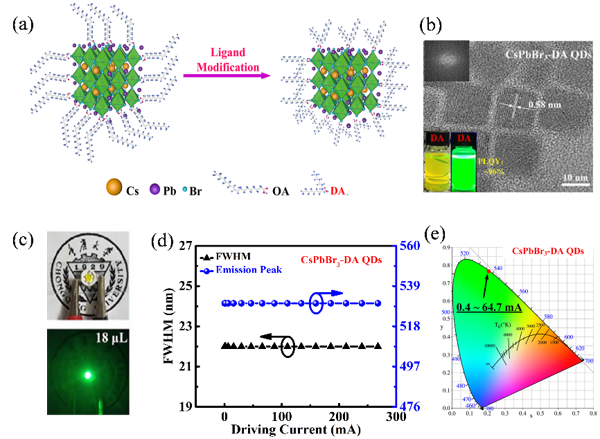Currently, commercial displays and lighting sources are commonly fabricated using red, green and blue LEDs. In general, those three different LEDs correspond to different luminescent materials with different lifetimes. With the efficiency of red, green and blue LEDs varies greatly, light-emitting devices suffer problems of color shift after being used for a period, affecting the display performance.
Although high-purity red and blue LEDs were reported, it is now still quite challenging in realizing high-purity green LEDs, mainly due to the difficulties in achieving high external quantum efficiency (EQE) and slow efficiency drop with green LEDs on GaN. Therefore, it is highly desirable and crucial to develop green LEDs with good monochromaticity, narrow bandwidth and high purity for the field of luminescence.
Due to the excellent optoelectronic properties and various synthesized routes, CsPbBr3 perovskite quantum dots (QDs) have been considered as one of the most promising candidates for green LEDs especially in recent years. Green LEDs with high monochromaticity can be prepared using CsPbBr3 QDs combined with blue chips as an excitation source, which solves the problems of color shift. However, the long alkyl ligands on the surface of the CsPbBr3 QDs might easily loss, causing instability issues. This affects the optical properties of CsPbBr3 QDs and hinders their practical applications in green LEDs.
To solve such issue, Professor Zhigang Zang's group from Chongqing University reported a ligand modification strategy to achieve high quality CsPbBr3 QDs, which show a significantly enhanced thermal stability and optical properties. The modified QDs were also used for green and white LEDs, showing ultra-pure green and white emissions, respectively. Those works were published in Photonics Research, vol. 8, issue 7, 2020.

Figure 1 (a) A schematic of the ligand modification process. (b) TEM images of the ligand modified CsPbBr3 QDs. (c) Green LED. (d) The emission peak and the FWHM under different injection currents. (e) The chromaticity coordinates of the devices.
In this work, CsPbBr3 QDs synthesized with 2-hexyldecanoic acid (DA) ligands were proved to exhibit better optical properties than those with conventional oleic acid (OA) ligands. Excellent stability as well as optical properties were achieved by the ligand modified CsPbBr3 QDs, which maintained 94.3% of their initial PL intensity even after one month, while the unmodified ones maintained only 21.2% of their initial PL intensity.
Using these ligand modified CsPbBr3 QDs, ultrapure and highly efficient green light-emitting LEDs were then demonstrated. The LEDs exhibit a stable luminescence center, FWHM and color coordinates with the increase of drive current and show no fluctuation during the whole test, which is quite challenging to realize using other color conversion materials such as phosphors and other QDs.
Furthermore, the WLEDs based on the ligands modified CsPbBr3 QDs exhibit an excellent luminescent performance, including a high color rendering index (CRI) of 93, a power efficiency of 64.8 lm/W, and a correlated color temperature value of 3018 K, demonstrating the great potential in fields such as displays and visible light communications.
The project research was supported by National Natural Science Foundation of China (11974063), Fundamental Research Funds for the Central Universities (2019CDJGFGD001) and Graduate Scientific Research and Innovation Foundation of Chongqing (CYB19036).
About the Author.
Zhigang Zang, Professor of College of Optoelectronic Engineering, Chongqing University. His interest is focused on the preparation of low-dimensional semiconductor materials and their related devices. He has been selected as a young scholar of the National Major Talent Project Program, and won the second prize of Natural Science of Chongqing, the Top Ten Science and Technology Youth Award of Chongqing, and the special award for 1st Sichuan and Chongqing Science and Technology Paper.



